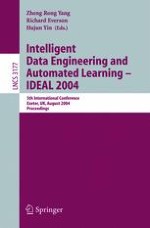2004 | Book
Intelligent Data Engineering and Automated Learning – IDEAL 2004
5th International Conference, Exeter, UK. August 25-27, 2004. Proceedings
Editors: Zheng Rong Yang, Hujun Yin, Richard M. Everson
Publisher: Springer Berlin Heidelberg
Book Series : Lecture Notes in Computer Science
Included in: Professional Book Archive
